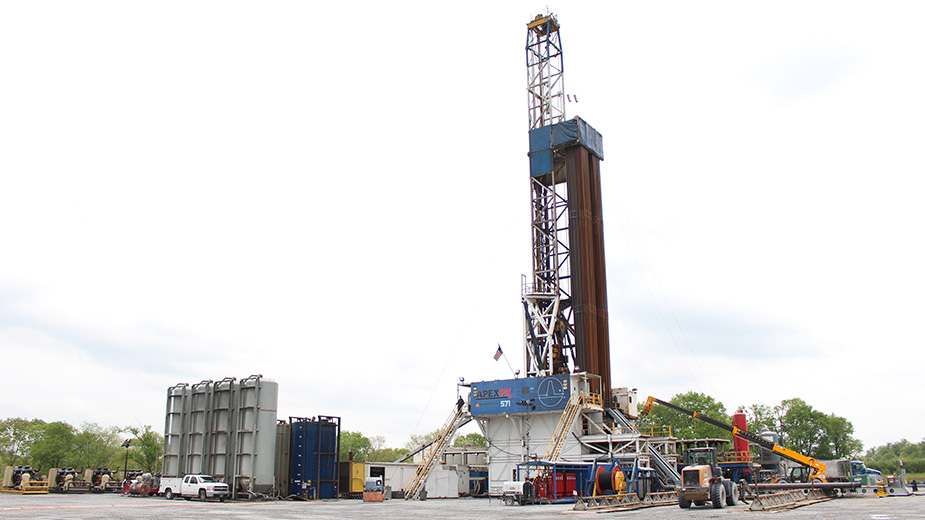Lawmakers Propose New Regs for Injection Wells
WARREN, Ohio – Two state legislators from Trumbull County and another from Ashtabula County say a bill they’ve sponsored in the Ohio House of Representatives will strengthen safety regulations associated with Class II injection wells.
State Reps. Sean O’Brien, D-Bazetta, Michael O’Brien, D-Warren, and John Patterson, D-Jefferson, say H.B. 422, if enacted, would sensibly regulate the industry and codify existing state rules.
“These are common sense regulations,” Sean O’Brien told reporters Tuesday during a press event at Trumbull County Career and Technical Center. “This bill also codifies what’s already in place.”
There are nearly 200 Class II injection wells across the state of Ohio and use of such wells is a common method of disposing wastewater byproducts from hydraulic fracturing. Fracking calls for the injection of a mixture of chemicals, water and sand at high pressure into wells with enough force to break open tight shale formations and release the oil and gas in the strata.
Wastewater that rises to the surface is contaminated, and therefore requires proper disposal.
Although the Ohio Department of Natural Resources has imposed or is writing new rules and regulations to govern the state’s injection wells, the three legislators say, some of those rules aren’t part of state law. Their bill would change that and establish a solid legal foundation for many of these agency regulations, O’Brien says.
Among the provisions of the bill:
- A prohibition on drilling injection wells within a 100-year floodplain.
- Requiring trucks that haul brine to injection wells to install GPS systems capable of transmitting real-time data.
- Real-time seismic testing at all injection well sites.
- Elimination of underground storage tanks that hold wastewater.
- Inclusion of dye additives on all water stored or injected at well sites.
- The immediate notification of county commissioners and township trustees of new injection well applications.
O’Brien noted that ODNR took steps to strengthen regulations in the wake of a series of earthquakes triggered by an injection well D&L Energy operated in Youngstown in 2011. That well was shut down, as were others the company owned in the area.
More recently — last April — wastewater seeping from an underground storage tank at an injection well in Vienna Township caused ODNR to shut down five of the company’s wells. The water contaminated a nearby pond and wetland. Kleese Development owned the well.
One problem in this instance was that the leak wasn’t detected immediately because the storage tank was underground, O’Brien says. Leaks from tanks above ground would be easier to identify because of their visibility. Plus, the use of dye would allow for faster visual detection and more rapid response time.
These incidents damaged not only to the environment, but to the industry as a whole, O’Brien says. Therefore, it’s in the best interests of the oil and gas industry to embrace this bill and its provisions. “The D&L and KDA incidents hurt the entire industry,” he said. “It would be beneficial for companies to come on board.”
Another important component of the bill is a provision requiring that county commissioners and township trustees be alerted of any new injection well application filed within their jurisdictions, noted Warren’s Michael O’Brien.
“It’s a key component,” he says. “It’s important to their constituents.”
County engineer departments are automatically notified and registered on the list of county engineers when a new oil or gas permit application is filed, Warren’s O’Brien says. This provision would result in immediate notification of these elected officials about any new applications.
Ensuring environmental safety is also a large concern for many in northeastern Ohio, notes Ashtabula County’s Patterson.
“We’re trying to strike a balance between economic development the oil and gas industry brings and environmental regulations,” he says. “Water quality is especially important to us on the Lake [Erie].”
Within the largest county in Ohio flow two important waterways, the Grand River and the Conneaut River, Patterson adds. They underscore the importance of prohibiting injection wells within a 100-year floodplain.
Bazetta’s O’Brien says that the bill should be assigned to a committee in roughly six weeks. Hearings should begin shortly thereafter, and the parties have been in touch with ODNR Director James Zehringer and Oil and Gas Division Chief Richard Simmers.
“The ODNR could perhaps look at this bill as a vehicle” for future policy, he said. “We’ve worked with environmentalists, the industry and both sides of the aisle.”
Pictured: State Reps. John Patterson, D-Jefferson, Sean O’Brien, D-Bazetta and Michael O’Brien, D-Warren, at Tuesday’s press conference.
Copyright 2024 The Business Journal, Youngstown, Ohio.

